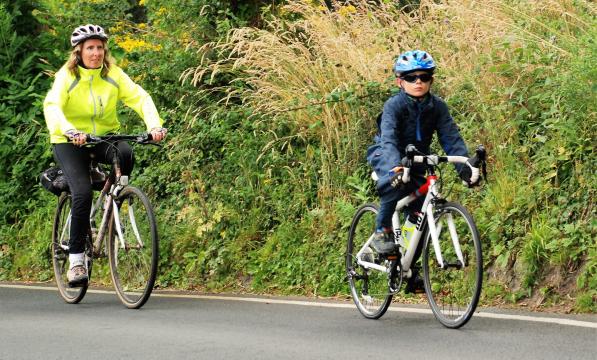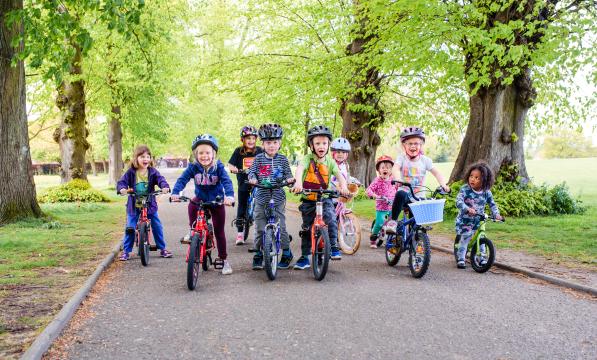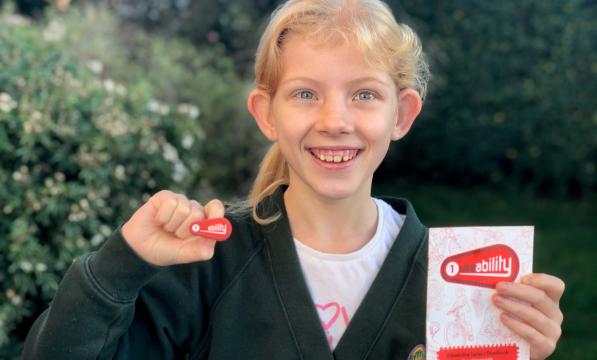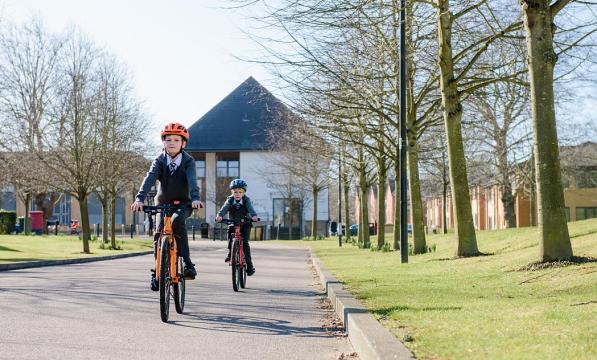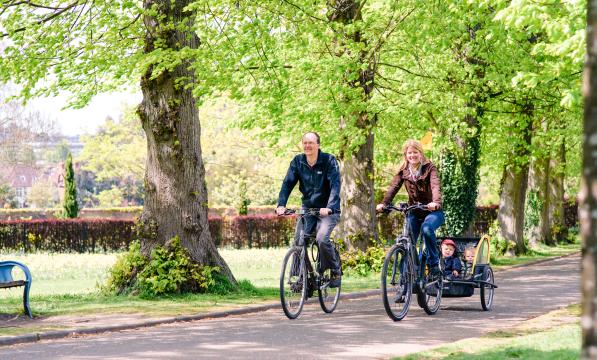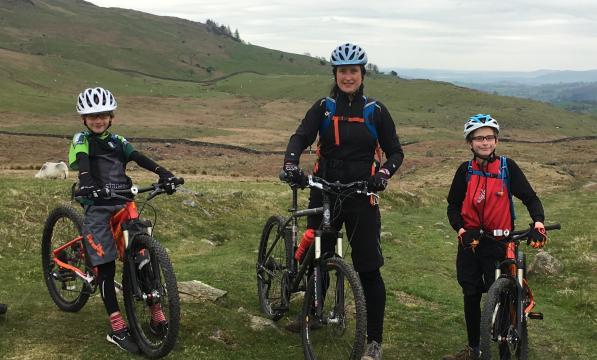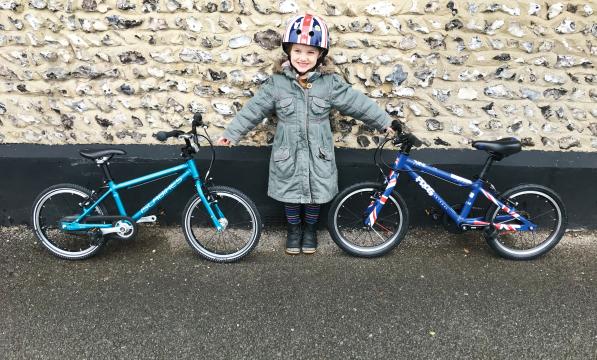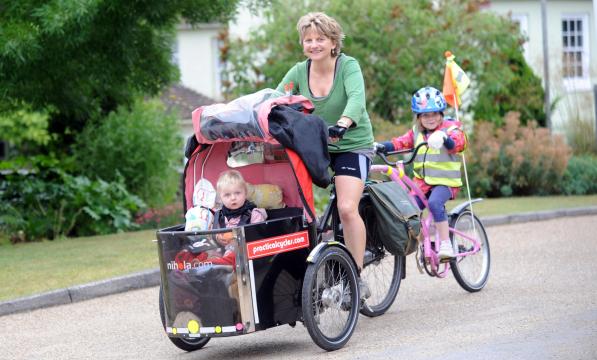How to go on a bike ride with children

Whether your children are tiny tots or tall teenagers, you can all have fun cycling together as a family. It’s a fantastic and healthy way to do something together, where everyone is involved and at the end there is a great sense of achievement, too.
If you’ve never cycled as a family before, start with a small journey first. If you’re a regular cyclist but everyone else is fairly new to cycling, you will need to go at their pace, otherwise you’ll put them off and there’ll be lots of moaning.
Molehills to you could be mountains to your family, and your meagre distance could be their taxing ride. One hour on the bike is more than enough for your first family adventure.
It shouldn’t just be about the journey, however; aim to go somewhere that everyone likes. If you have small children, try riding to a playground, the beach or a family-friendly café or pub.
Get older children involved in choosing a place they would like to visit. Perhaps you could combine the ride with a visit to a castle, beach, museum, shopping or the cinema.
How far and how fast?
For small children on their own bikes, five or 10 miles is a real achievement; youngsters in child seats, on the back of tandems or on trailer-cycles should manage a bit further. Until a few rides have given you a more reliable guide, assume your average speed will be no more than 5mph (including short, unplanned stops).
If you make better time than this, it’s not a problem. It’s better to underestimate. You don’t want the ride to become an unpleasant endurance exercise. You can always extend trips up to 20 or 30 miles, or even further, as time goes by.
There are a few things you can do to help level out your riding speeds, so you’re not accidentally drifting off the front. First, make sure the child seat or trailer is on your bike, or that you’re riding the trailer-cycle. Secondly, you should carry the luggage yourself – everything from spare jumpers and jackets to the toolkit and picnic. Lastly, change down to a really easy hill-climbing gear so that you’re ‘speed limited’.
Choose your route
In a perfect world, you would have time to ride the route yourself before you take your family with you. If you can’t do that, make sure you know where you are going and have a good map or carry a navigation device. If you have a smartphone, you can usually navigate using that as well.
A paper map is still a valuable touring accessory, however. For a start, it won’t run out of batteries or stop working if you drop it. In a car you can follow road signs to get where you want to go, but as such signs are usually designed for motor traffic, they will guide you down the biggest, quickest roads.
Those are the last places you want to be with your family! With a detailed map, you can plot your own route from A to B via lanes, tracks and back roads – something that can also be done using online route planners such as bikehike or CycleStreets.
There’s a vast library of routes, guides and maps on Cycling UK’s Routes section. Harvey and Goldeneye do some very nice maps for cyclists for areas of the country popular with tourists.
The best maps with nationwide coverage are by Ordnance Survey. The 1:50,000 Landrangers are more useful for cycling on roads than the 1:25,000 Explorers you might use off-road, because each map covers a greater area: a chunk of the country 40km (25 miles) across.
On Landrangers, main roads (A roads) are coloured red – apart from the even busier ‘primary routes’ (also A roads), which are coloured green. Plan any route to avoid both as far as possible, especially primary routes.
Busy roads make touring feel like commuting, and if you’re accompanied by less confident cyclists even a few miles on one can spoil your day. Use minor roads (coloured yellow or white) or, when they’re unavailable, B roads (orange).
Since the shortest point between two places will usually be linked by the biggest road, this will often mean taking a longer, more roundabout route. But that’s the essence of touring anyway: enjoying the journey, not minimising the journey time.
Of course, roads aren’t your only option. Sustrans’ National Cycle Network is a 14,000-mile (and growing) UK-wide web of signed cycle routes. While two-thirds of the network is on minor roads, the rest is traffic free thanks to segregated cycle tracks, canal towpaths and reclaimed, disused railways.
Day rides don’t have to begin at your own back door. You can explore further afield by driving or taking the train to a different start point. If you’re travelling by train, you can come back via a different station. If you’re travelling by car, one parent can stay with the children – perhaps in a café – while the other rides back to pick up the car.
Be prepared
Preparation doesn’t end with the route. One of the hardest parts of cycling with small children is simply getting out of the door. It can feel like an expedition. Minimise morning prep time.
The night before: check the bikes and equipment; make the packed lunch; lay out clothes; and prepare a pannier or seat pack with tools, first aid kit, and so on. If you have to fuss around fixing things before you set off, children get fractious.
At the very least, prepare the bikes the night before. Make sure that the tyres are properly inflated, that all bolts are tight, and that brakes and gears work OK. Better still, do this the day before: that way you’ve got time to nip out and buy, say, a new inner tube or brake cable.
Your bike will probably be in good running order if you use it often. Your family’s bikes might not be. Mostly that’s because they’re not riding them, and a problem that you would have corrected on your own bike could go unnoticed – and get worse.
Helpful advice
The more you involve your family in the ride, the more they’ll get out of it. Where does your partner want to go? Your children? Discuss the route options together. Use the map to talk through the realities of the route.
This is useful during the ride, too. If anyone’s getting tired, it helps to be able to say: “Look, we’re nearly there. Lunch is just round this corner.”
You and your family may have different criteria for what constitutes a good bike ride. If your children are happy, however, you will be, to, so focus on what they want. Children are often more impressed with the cake they can have in the café than with nice scenery.
A ride that’s a washout because of the weather can be saved in their eyes when you bring out a surprise comic or a favourite toy.
One of the strengths of cycling is that it’s an activity the whole family can enjoy. That means it also provides an opportunity to talk to and listen to your children, in a way that hectic modern lifestyles leave little time for. It’s precious one-to-one time, and your children may think more fondly of bike rides for that reason.
You can use the children’s conversations as a barometer of how they’re feeling on the ride. If they go quiet or start whingeing, they’re tired. Time to rest or have a snack. If it’s harder than you thought – maybe it’s hillier or the weather’s against you – revise your route. Turn around. Take a shortcut. Quit while you’re ahead.
The pace of the ride needs to be geared to the slowest family member. It’s demoralising if you cycle ahead, wait at the top of a hill for the others, then immediately set off again. And it’s just bad form. It’s like putting six goals past your child in a back garden game of football and celebrating each one.
Generally speaking, it’s better to ride behind your children if they are on their own bikes, whether you are riding on or off road. That way you can keep an eye on them, warn them of any hazards ahead, and also make sure they haven’t stopped half a mile behind to tie up a shoelace or watch an interesting bird.
If you are riding in traffic, you can also shield your child or children from overtaking vehicles by riding behind and a little to the right of them – this will also give you the opportunity to teach them good riding skills for when they take to the saddle by themselves one day.
If the children aren’t bringing up the rear, it’s easy to set your pace by theirs. It’s even easier on traffic-free off-road routes. So long as you can still see your children, you can let them roam ahead. This lets them discover things first, and it automatically means that you’re travelling at their pace. If anyone falls off or stops, you’ll be able to react straight away.
Being in front, they have the opportunity to initiate any stops. And they will want to stop more often than you: for a drink, to have a rest, to say hello to the horse in the field, whatever. If they want to stop, stop. There’s no rush. If the hill’s too steep or the descent too technical, get off and push.
Forget about cycling to get somewhere or to get an adrenaline buzz – smell the flowers. Conversely, if everyone else is cycling along happily, try not to stop them too often for photographs. Ride ahead, stop, shoot them coming past, then catch up. Get your pictures when everyone’s fresh – early on, after lunch, or at your destination.
10 things to bring on a family bike ride
- Plenty of drinks. Water in plastic bicycle bottles (750ml per person, or more) is best. It can also be used for washing hands or cooling down on sunny days, whereas juice can’t.
- Snacks. Energy boost and morale boost in one. Fuel is much the same as for other forms of cycling: cereal bars, fruit, fig biscuits, cakes.
- Extra layers. Wind- and shower-proof jackets all round. Fleeces or jumpers for the kids for when you stop. Gloves or cycling mitts can stop small hands getting sore, especially if they are not used to riding, and are essential if the weather is chilly – unless they are pedalling hard, children’s hands and feet can get cold very quickly.
- Spare wipes, nappies/pants and trousers. For babies and just potty-trained toddlers. It will happen. Also a plastic bag for the wet stuff.
- Toolkit. Pump, tyre levers, puncture kit, spare inner tube for each wheel size, multi-tool. Even if you’re not a mechanic, you may meet a Good Samaritan who can help you out – if you’ve got the necessary equipment.
- ‘First aid’ kit. Plasters, antiseptic cream, painkillers, Factor 50 sun cream in summer, wet wipes. Plus any required medication.
- Mobile phone, for unlikely emergencies
- Cash. You might not think you’ll need it, but it’s nice to have the option of buying ice lollies or cups of tea if they’re available.
- Lock. Even it’s just a lightweight immobiliser to run through the bike frames outside a café.
- Distractions. For the children – a tennis ball, Frisbee or action figure for instance.
And, finally, don’t forget patience and a sense of humour – remember it won’t be long before they’re waiting for you to catch up with them!

